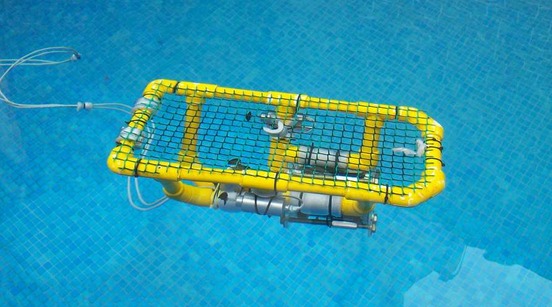Build an underwater rov
Build a small tethered underwater ROV using plastic bottles, a sealed motor (with adult help) or pulley, adjust buoyancy, and test movement.



Step-by-step guide to build an underwater ROV
Kid Engineer: Underwater R.O.V. | Design Squad
Step 1
Gather all materials and put them on a clean table so everything is easy to reach.
Step 2
Tape the two plastic bottles firmly side by side with their caps pointing the same way to make a stable float base.
Step 3
Use scissors or a craft knife with an adult to cut a small slot at the back end of the two taped bottles for the motor shaft or pulley axle.
Step 4
Pick your drive method by choosing either the sealed motor option OR the pulley option.
Step 5
If you chose the sealed motor ask an adult to connect the motor to the battery pack outside the water.
Step 6
Ask the adult to place the battery pack and any exposed connections inside the waterproof plastic bag and seal it tightly.
Step 7
Insert the motor shaft or pulley axle through the rear slot and secure the motor or pulley to the bottles with waterproof tape and zip ties.
Step 8
Attach a simple propeller to the motor shaft OR tie the tether string around the pulley so pulling the tether will turn the pulley.
Step 9
Tape pieces of foam from the pool noodle to the top of the bottles to add buoyancy and keep the ROV from tipping.
Step 10
Add small weights under the bottles with tape a little at a time until the float sits level in your hand.
Step 11
Tie one end of the strong string or rope to the front of the float to make the tether and leave the other end for control.
Step 12
Gently lower the ROV into a bathtub or shallow pool until it is fully submerged.
Step 13
Turn on the motor or gently pull the tether to move the ROV and watch how it swims.
Step 14
Adjust the foam or weights and repeat tests until the ROV moves the way you want it to.
Step 15
Share a photo or video of your finished underwater ROV and what you learned on DIY.org.
Final steps
You're almost there! Complete all the steps, bring your creation to life, post it, and conquer the challenge!


Help!?
What can we use if we don't have two plastic bottles or a sealed motor?
Use any two clean, similarly sized sealed plastic containers (for example yogurt tubs with tight lids) taped side-by-side as the float base and, if you lack a sealed motor, choose the pulley-and-tether drive method described in step 4.
My ROV won't move or it keeps sinking—what should I check?
Check that the battery pack is connected and fully sealed inside the waterproof plastic bag, the propeller is firmly attached to the motor shaft or the tether is properly tied around the pulley, and adjust or remove taped weights and add pool noodle foam until the float sits level as instructed.
How can I simplify or make this project harder for different ages?
For younger kids skip the sealed motor and use only the pulley/tether option with an adult doing the slot cutting and taping, while older kids can wire the sealed motor themselves and experiment with changing foam placement and adding weights per steps 9–12 to fine-tune buoyancy and movement.
What are fun ways to improve or personalize the ROV after it works?
Enhance the ROV by taping foam fins or craftboard rudders to the bottles for better steering, mounting waterproof LED lights or a small camera inside the sealed bag to record swims, and decorating the bottles before sharing photos or videos on DIY.org.
Watch videos on how to build an underwater ROV
An underwater robot with a mission
Facts about underwater robotics for kids
♻️ Plastic (PET) bottles are great DIY ROV hulls because they're lightweight, waterproof, and easy to seal and modify.
⚖️ Archimedes' principle explains buoyancy: an object floats when it displaces a volume of water equal to its weight.
⚙️ Many kid-friendly ROVs use sealed motors or simple pulley systems for movement—pulleys can be safer and easier to build.
🌊 Some ROVs have explored the deepest place on Earth—the Mariana Trench—reaching depths over 10,900 meters!
🔌 The tether is the ROV's lifeline: it carries power and control signals and helps you reel the vehicle back to shore.
How do I build a small tethered underwater ROV using plastic bottles?
What materials do I need to build a tethered underwater ROV with plastic bottles?
What ages is building a tethered underwater ROV suitable for?
What safety tips and variations should I consider for a homemade underwater ROV?


One subscription, many ways to play and learn.
Only $6.99 after trial. No credit card required



